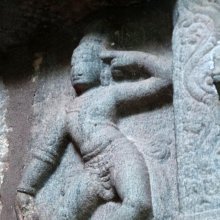Tripatakahasta, Tripataka-hasta, Tripatākahasta: 1 definition
Introduction:
Tripatakahasta means something in Hinduism, Sanskrit. If you want to know the exact meaning, history, etymology or English translation of this term then check out the descriptions on this page. Add your comment or reference to a book if you want to contribute to this summary article.
Images (photo gallery)
In Hinduism
Natyashastra (theatrics and dramaturgy)
Source: Shodhganga: Elements of Art and Architecture in the Trtiyakhanda of the Visnudharmottarapurana (natya)Tripatākahasta (त्रिपताकहस्त) or simply Tripatāka refers to one of the twenty-two Asaṃyuktahastas or “single hand gestures” (in Indian Dramas), according to the Viṣṇudharmottarapurāṇa, an ancient Sanskrit text which (being encyclopedic in nature) deals with a variety of cultural topics such as arts, architecture, music, grammar and astronomy.—The hasta-mudrās (lit. “hand-gestures”) are very essential to denote some particular action or state in dancing and these mudrās are formed with the help of hands and fingers. In the Viṣṇudharmottarapurāṇa, twenty two kinds of asaṃyuktahastas (“dancing postures made only by single hand”) are mentioned. e.g., tripatākahasta.

Natyashastra (नाट्यशास्त्र, nāṭyaśāstra) refers to both the ancient Indian tradition (shastra) of performing arts, (natya—theatrics, drama, dance, music), as well as the name of a Sanskrit work dealing with these subjects. It also teaches the rules for composing Dramatic plays (nataka), construction and performance of Theater, and Poetic works (kavya).
See also (Relevant definitions)
Partial matches: Hasta, Tripataka.
Query error!
Full-text: Indra, Three, Auspicious touch, Motita, Ishana, Agni, Wiping, Covering, Calling, Lamp, Arrow, Writing, Candra, Kalki, Crown, Scissor, Tripataka, Narasimha, Kartarimukha.
Relevant text
Search found 3 books and stories containing Tripatakahasta, Tripatāka-hasta, Tripataka-hasta, Tripatākahasta; (plurals include: Tripatakahastas, hastas, Tripatākahastas). You can also click to the full overview containing English textual excerpts. Below are direct links for the most relevant articles:
Gati in Theory and Practice (by Dr. Sujatha Mohan)
Description of Gati in Abhinayadarpaṇa < [Chapter 2 - Concept and technique of Gati]
Gati performed in Pūrvaraṅga < [Chapter 3 - Application of gati in Dṛśya-kāvyas]
Vishnudharmottara Purana (Art and Architecture) (by Bhagyashree Sarma)
2.2. Hand Postures (a): Asaṃyukta-hasta < [Chapter 3 - Drama and Dance]
Hastalaksanadipika a critical edition and study (by E. K. Sudha)
